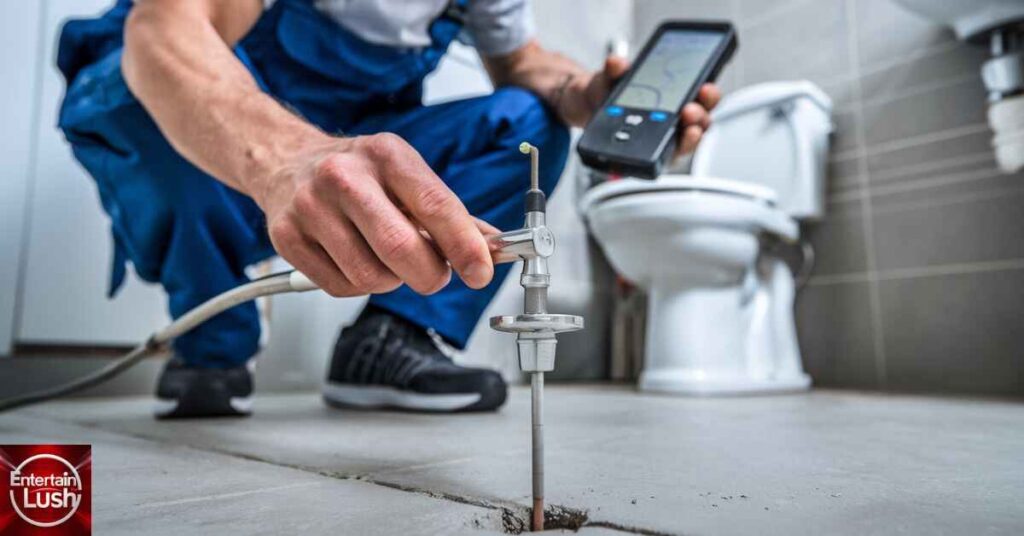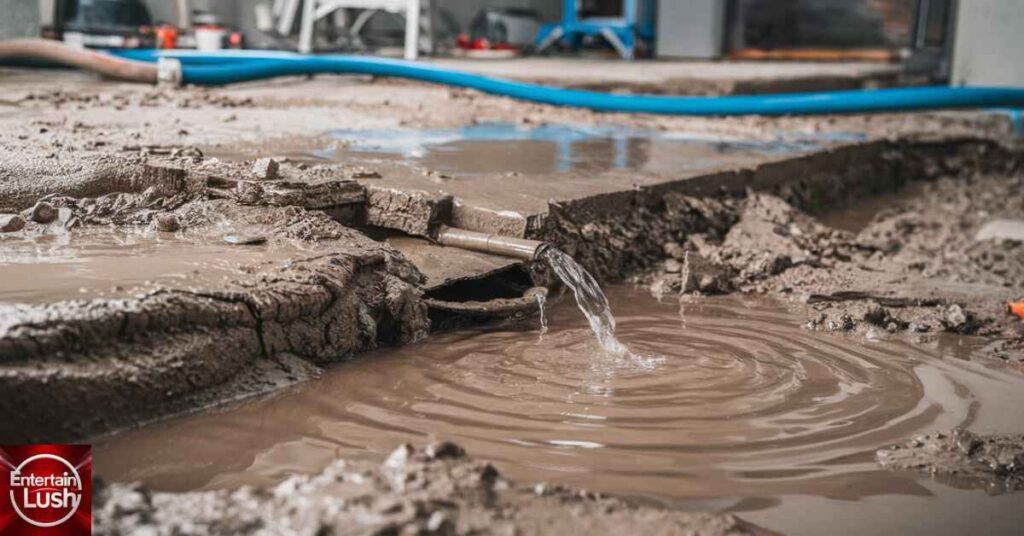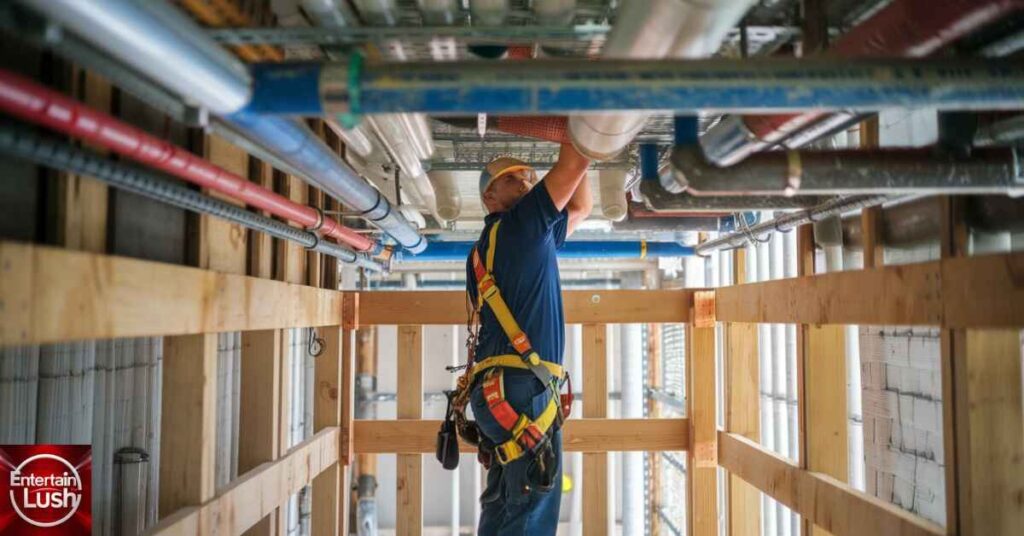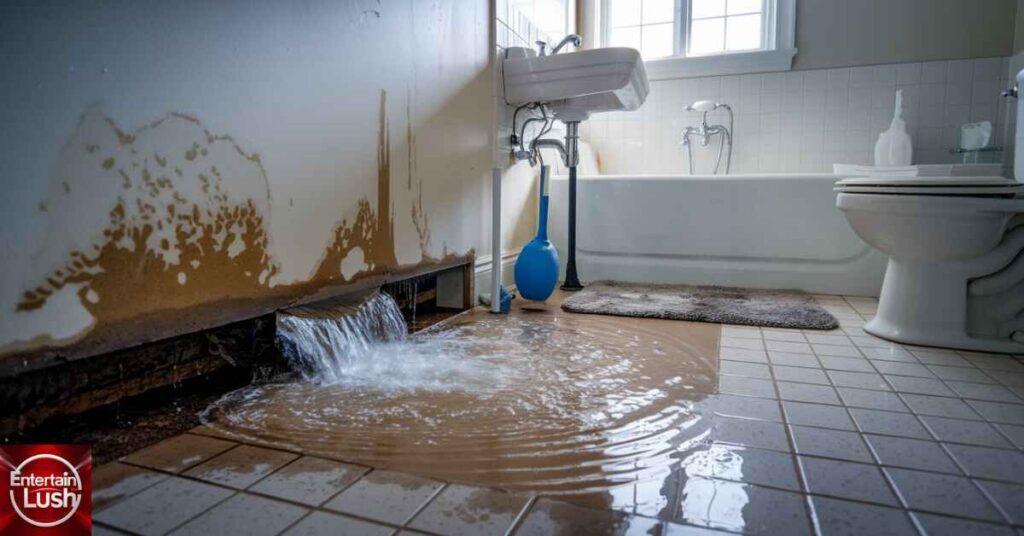Slab leaks can be a homeowner’s nightmare, causing extensive damage and hefty repair bills. Many property owners are left wondering if their insurance will cover these costly issues. Understanding your policy’s coverage for slab leaks is crucial, as it can mean the difference between financial security and significant out-of-pocket expenses.
This comprehensive guide will unravel the complexities of slab leak insurance coverage, helping you navigate your policy terms and prepare for potential claims. Learn when insurers typically cover slab leaks and what steps you can take to protect your home and finances.
What is a Slab Leak?
A slab leak occurs when water pipes beneath a home’s concrete foundation break or corrode. This issue leads to water seeping into the foundation, causing damage. Slab leaks are often hard to detect because the pipes are hidden under thick concrete. They can result from various factors, including soil movement, poor construction, or aging plumbing systems.
Common Causes of Slab Leaks
Several factors can cause slab leaks. Soil shifting puts pressure on pipes, leading to cracks. Corrosion of older pipes weakens them over time. Poor installation during construction can result in weak spots. Water quality issues, like high acidity, can erode pipes from the inside. External damage from construction work or natural disasters can also trigger slab leaks.
Potential Consequences of Untreated Slab Leaks
Ignoring slab leaks can lead to severe problems. Water damage can weaken the foundation, causing structural issues. Mold growth becomes a health hazard in damp conditions. Energy bills may increase due to constant water flow. Property value can decrease significantly. Repairs become more extensive and costly over time. Quick action is essential to prevent these serious consequences.
Identifying Slab Leaks
Detecting slab leaks early is crucial. Look for unexplained increases in water bills. Listen for running water when all taps are off. Check for warm spots on the floor, which may indicate hot water leaks. Watch for cracks in walls or floors. Observe any unexplained dampness or mold growth. If you notice these signs, contact a professional for a thorough inspection.
Signs You May Have a Slab Leak
Several signs can indicate a slab leak. Unusually high water bills are a common red flag. Damp or wet spots on floors, especially carpets, may appear. You might hear water running when no taps are on. Low water pressure throughout the house is another symptom. Cracks in walls or flooring can develop. Mold or mildew smell in rooms can also signal a hidden leak.
Professional Slab Leak Detection Methods

Experts use advanced techniques to find slab leaks. Acoustic listening devices can pinpoint the sound of leaking water. Infrared cameras detect temperature differences caused by leaks. Pressure testing helps identify drops in water pressure. Video pipe inspection allows visual examination of pipe interiors. These methods help locate leaks accurately without extensive digging or damage to your property.
DIY vs. Professional Detection: Pros and Cons
DIY leak detection can save money initially. You can check for visible signs like water spots or high bills. However, it’s often inaccurate and misses hidden leaks. Professional detection is more reliable. Plumbers use specialized tools for precise location. They can assess damage extent better. While costlier upfront, professional detection prevents further damage and saves money long-term.
Homeowners Insurance and Slab Leaks
Homeowners insurance may cover slab leaks, but it depends on your policy. Most policies cover sudden, accidental water damage. However, they often exclude long-term leaks or wear and tear. It’s important to read your policy carefully. Some insurers offer additional coverage for slab leaks. Contact your insurance agent to understand your specific coverage.
Types of Homeowners Insurance Relevant to Slab Leaks
Two main types of coverage apply to slab leaks. Dwelling coverage protects the structure of your home. It may cover the cost of accessing and repairing the leak. Personal property coverage protects your belongings. It can help replace items damaged by water from the leak. Some policies offer additional water damage coverage. Review your policy to understand your specific protections.
Dwelling Coverage for Slab Leaks
Dwelling coverage may help with slab leak repairs. It typically covers the cost of accessing the leak. This includes breaking through the concrete slab. It also covers repairing damage caused by the leak. However, it may not cover the cost of fixing the pipe itself. Coverage limits and deductibles apply. Check your policy for specific details.
Personal Property Coverage and Slab Leaks
Personal property coverage protects your belongings from slab leak damage. It can help replace water-damaged items like furniture or carpets. Coverage limits vary by policy. Some items may have special limits. Keep an inventory of damaged items. Take photos for your claim. Remember, you’ll need to pay your deductible before coverage kicks in.
When Insurance Covers Slab Leaks
Insurance typically covers slab leaks in certain scenarios. Sudden, accidental leaks are often covered. Damage from burst pipes is usually included. Coverage may apply if the leak results from a covered peril like storms. However, long-term leaks or wear and tear are often excluded. Read your policy carefully to understand your coverage.
Sudden and Accidental Damage
Insurance policies generally cover sudden and accidental damage. This includes unexpected pipe bursts or sudden leaks. The key is that the damage happens quickly and without warning. It shouldn’t be due to neglect or lack of maintenance. If you discover a leak and act promptly, it’s more likely to be covered. Document the damage immediately for your claim.
Slab Leaks Resulting from Covered Perils

Insurance often covers slab leaks caused by specific events. These include fire damage to pipes. Storm damage that leads to leaks is typically covered. Fallen trees that break pipes are usually included. Lightning strikes causing pipe damage are covered. Vehicle impacts that harm plumbing may be covered. Always check your policy for the exact list of covered perils.
The Claims Process for Covered Slab Leaks
To file a claim, first contact your insurance company. Document the damage with photos and videos. Keep receipts for any emergency repairs. An adjuster will inspect the damage. They’ll determine if the leak is covered. Provide all requested information promptly. The insurer will then decide on your claim and explain the next steps.
When Insurance May Not Cover Slab Leaks
Insurance doesn’t always cover slab leaks. Gradual damage from long-term leaks is often excluded. Leaks caused by lack of maintenance aren’t usually covered. Some policies exclude certain types of water damage. Earth movement causing leaks might not be covered. Always review your policy’s exclusions carefully. If in doubt, ask your insurance agent for clarification.
Gradual Damage and Wear and Tear
Insurance typically doesn’t cover gradual damage. This includes slow leaks that worsen over time. Normal wear and tear on pipes isn’t covered. Neglecting regular maintenance can lead to denied claims. Insurers expect homeowners to address small issues before they become big problems. Keep records of your home maintenance to support potential claims.
Pre-existing Conditions
Insurance doesn’t cover pre-existing slab leaks. These are issues that existed before you bought the policy. You must disclose known problems when purchasing insurance. Undisclosed issues can lead to denied claims later. If you suspect a leak when buying a home, have it inspected. Address any issues before getting insurance coverage.
Policy Exclusions and Limitations
Most policies have specific exclusions. Flood damage is often excluded from standard policies. Earth movement, like earthquakes, may not be covered. Some policies limit coverage for certain types of water damage. Mold resulting from long-term leaks might be excluded. Review your policy’s exclusions carefully. Consider additional coverage for excluded perils if needed.
Read This Blog: Dubai First Credit Card: The Ultimate Guide to Rewards, Features, and Benefits
Slab Leak Repair Costs and Considerations
Repair costs for slab leaks vary widely. They depend on leak location and severity. Accessing the leak can be expensive. Foundation repairs add to the cost. Plumbing work is another expense. Consider water damage restoration costs too. Get multiple quotes from reputable contractors. Understand what’s included in each estimate before deciding.
Average Costs of Slab Leak Repairs
Slab leak repairs typically cost between $2,000 and $6,000. Simple repairs might be as low as $500. Complex cases can exceed $10,000. Detecting the leak usually costs $150 to $400. Concrete cutting and restoration add $500 to $1,500. Plumbing repairs range from $200 to $2,500. Water damage restoration can cost $1,000 to $4,000 extra.
Factors Influencing Repair Costs
Several factors affect slab leak repair costs. Leak location impacts accessibility and repair method. Severity of the leak determines repair extent. Your home’s age and construction type matter. Local labor and material costs vary. The chosen repair method affects price. Extent of water damage influences overall cost. Get detailed assessments for accurate estimates.
Insurance Deductibles and Out-of-Pocket Expenses
Your insurance deductible is your initial out-of-pocket cost. You pay this amount before insurance coverage kicks in. Deductibles typically range from $500 to $2,500. Higher deductibles usually mean lower premiums. Some repairs might cost less than your deductible. In these cases, you’d pay the full amount. Consider your deductible when deciding to file a claim.
Also Read: Appfordown: Your Go-To Platform for Safe App Downloads
Preventing Slab Leaks and Mitigating Risks

Preventing slab leaks saves money and stress. Regularly inspect your plumbing system. Address small issues before they become big problems. Maintain proper water pressure in your home. Avoid using harsh chemicals in drains. Consider upgrading old plumbing systems. Install a leak detection system for early warnings. Proper landscaping can prevent soil issues affecting your foundation.
Regular Home Maintenance Tips
Perform regular plumbing checks. Look for signs of leaks around your home. Monitor your water bill for unusual increases. Check water pressure annually. Inspect visible pipes for corrosion. Clear drains regularly to prevent blockages. Have a professional plumbing inspection every few years. Address any foundation issues promptly. Keep gutters clean to prevent water damage.
Upgrading Plumbing Systems
Upgrading old plumbing can prevent slab leaks. Consider replacing copper pipes with PEX tubing. PEX is more flexible and resistant to corrosion. Rerouting pipes above the slab eliminates underground leaks. Install shut-off valves for better control. Upgrade to pressure-regulating valves to prevent stress on pipes. Modern plumbing materials last longer and resist leaks better.
Importance of Quick Action and Professional Help
Act quickly if you suspect a slab leak. Early detection minimizes damage and repair costs. Hire a professional plumber for accurate diagnosis. They have tools to locate leaks precisely. Professional repairs ensure proper fixing of the issue. Quick action can prevent mold growth and structural damage. It also strengthens your insurance claim if needed.
FAQ
What is the difference between a slab leak and a regular plumbing leak?
A slab leak occurs under a home’s concrete foundation, while a regular plumbing leak happens in accessible pipes inside the house.
How long does it take for insurance to process a slab leak claim?
Insurance claims for slab leaks typically take 1-4 weeks, depending on the complexity and the insurer’s process.
Can I stay in my home during slab leak repairs?
Yes, but it depends on the severity of the damage. Extensive repairs might require temporary relocation.
Will my insurance rates increase if I file a slab leak claim?
Filing a claim can lead to increased premiums, but it depends on your insurer and claim history.
Are there any insurance add-ons or riders specifically for slab leak coverage?
Yes, some insurers offer water damage riders or endorsements that cover slab leaks beyond standard policies.
Conclusion
Slab leaks can cause serious damage to your home if ignored. It’s important to understand your insurance policy and know what’s covered. Sudden leaks are often included, but wear and tear are not. Regular home maintenance can help prevent leaks. If you suspect a slab leak, act quickly to avoid costly repairs and protect your home.
Mr. Dravid is the dedicated author of the business category on Entertainlush.com. With a keen eye for industry trends and a passion for insightful analysis, he delivers valuable content that empowers readers to stay ahead in the ever-evolving business landscape. His expertise ensures that every article is both informative and engaging, helping audiences navigate the complexities of the business world.







